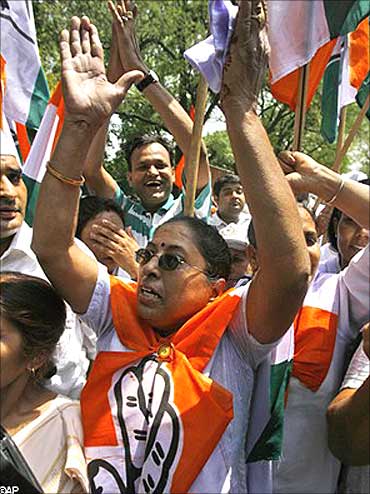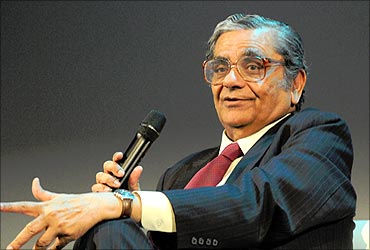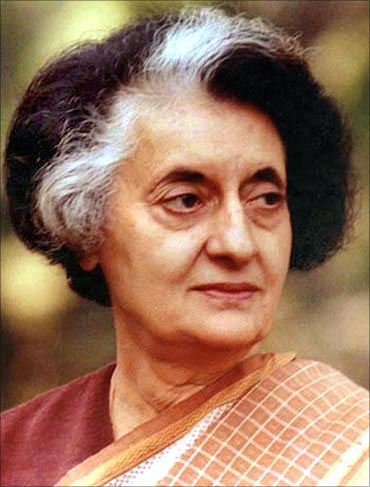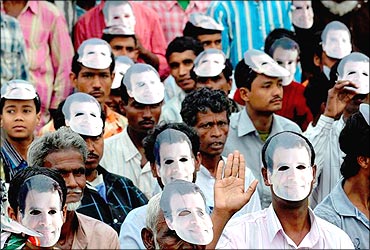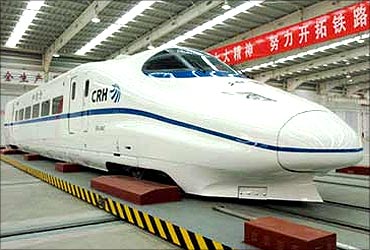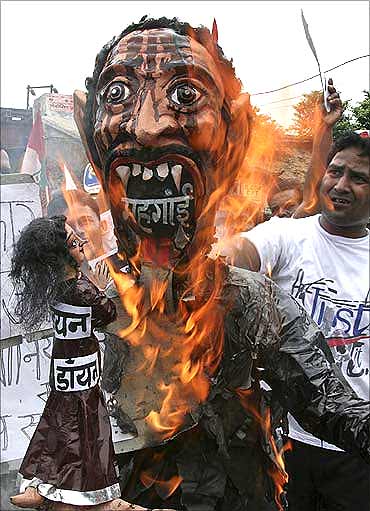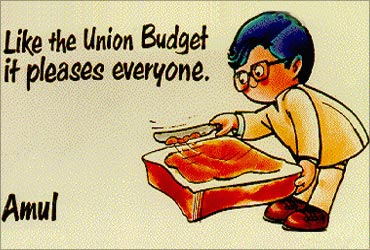The economics behind the Congress Budget
Last updated on: February 23, 2011 17:21 IST
Larry Summers, the recently departed Chairman of US President Barack Obama's National Economic Council, posed the following question before his trip to India last November: "What is the self-perception of the Congress as a political party?"
In fact, this broad question provokes three specific ones in the domain of economics. Is the Congress the party of Jagdish Bhagwati or Amartya Sen; Nehru or Indira Gandhi; or Aruna Roy or Nandan Nilekani?
Click NEXT to read on . . .

The economics behind the Congress Budget
Last updated on: February 23, 2011 17:21 IST
The upcoming Budget provides an excuse to reflect on these questions. Responses to them should underpin the specific fiscal policy choices and broader economic policy priorities that feature in the Budget. Consider each in turn.
<B>Bhagwati vs Sen: </B>The Bhagwati-Sen opposition relates to whether promoting growth or focusing on equity is the key objective. Three points are worth mentioning here. Insofar as one must choose, it is fiendishly difficult to do so.
Click NEXT to read on . . .

The economics behind the Congress Budget
Last updated on: February 23, 2011 17:21 IST
The choice will depend on the goals of policy and the relative costs and benefits of the instruments used to achieve each of them.
A different response to this choice is, of course, to deny it or stress its false nature and assert that both matter.
But the Bhagwati school would rightly claim that without growth there might not be adequate resources for spending on the poor.
Click NEXT to read on . . .

The economics behind the Congress Budget
Last updated on: February 23, 2011 17:21 IST
Perhaps the most interesting response is that many of the policy choices are really constrained by politics and limited government capacity, so that the implicit assumption that there might be a choice at all is open to question.
Nehru vs Indira Gandhi: The opposition here is between stability and prudence on the one hand and populism on the other.
For much of India's economic past, Indian policy makers exhibited an almost pathological penchant for stability, reflected in low inflation and fiscal rectitude.
Click NEXT to read on . . .

The economics behind the Congress Budget
Last updated on: February 23, 2011 17:21 IST
The stability in the Nehru era was the compensation for the Hindu rate of growth that characterised it.
Mrs Gandhi, of course, was a rank populist, and its most damaging economic manifestation was India's first real disavowal of fiscal and macroeconomic prudence after she returned to power in 1980.
Aruna Roy vs Nandan Nilekani: There are two contrasts here - suggested by Pratap Bhanu Mehta - on how the equity objective should be approached, relating respectively to the animating spirit and to the means deployed.
Click NEXT to read on . . .

The economics behind the Congress Budget
Last updated on: February 23, 2011 17:21 IST
The Aruna Roy approach views the poor as weak, as victims, as lacking in real agency, and hence deserving of the protective embrace of the state.
The Nandan Nilekani approach would view the poor in less despairing terms, and ascribe their poverty largely to lack of opportunity.
A second important distinction relates to the means deployed to achieve the equity objective.
The Roy approach, reflected in the history of the Indian government intervention, would entail "caring" for all aspects of the lives of the poor, leading to employment guarantees, subsidised food, water, electricity and credit.
Click NEXT to read on . . .

The economics behind the Congress Budget
Last updated on: February 23, 2011 17:21 IST
Under the Nilekani approach, equity would not be sacrificed or even demoted. Instead, more effective policy instruments - notably targeted transfers - would be used to meet the needs of the poor.
The Congress party has answered these questions forcefully, unambiguously, and to some extent, unfortunately in favouring Sen over Bhagwati, Mrs Gandhi over Nehru, and Roy over Nilekani.
Although India has grown rapidly, one might argue that this has less to do with policy changes and a lot to do with the mystifying fact that growth has been on autopilot because of a growth-generating-growth dynamics.
Click NEXT to read on . . .

The economics behind the Congress Budget
Last updated on: February 23, 2011 17:21 IST
On the other hand, since 2004, when it returned to power, the Congress has made the pursuit of equity its over-riding objective and has done so with a healthy dose of fiscal and legislative populism at the expense of stability.
The Congress has implemented one of the world's biggest employment guarantee schemes in NREGA; it has generously granted loan waivers; it has enshrined into law the right to education and the right to food security, to name some of the most important pro-poor initiatives.
Click NEXT to read on . . .

The economics behind the Congress Budget
Last updated on: February 23, 2011 17:21 IST
The Congress interpreted its two-peat victory in the 2009 elections as a vindication of its pro-poor shift and has, therefore, continued to lurch leftward.
To be fair, an effort has been made at reining in subsidies, for example, for fertilisers and some petroleum products. But this effort is notable for the modesty of its ambition.
The demotion of stability by the Congress is especially ironic. It repudiates the one success from India's past and ignores the central lesson from the recent global economic experience.
Click NEXT to read on . . .

The economics behind the Congress Budget
Last updated on: February 23, 2011 17:21 IST
This lesson, exemplified best by China, is the need for a sound public sector balance sheet as the only insurance against large financial crises.
So, while the world obsesses about stability, India remains doggedly populist. On Roy vs Nilekani, one might say the state's protective embrace has become a smothering embrace. Poverty, to be cynical, has become a constituency to be nurtured rather than a scourge to be eliminated.
Also, using the price system to achieve equity objectives via wide-ranging subsidies and guarantees has led neither to the achievement of efficiency nor the promotion of equity.
Click NEXT to read on . . .

The economics behind the Congress Budget
Last updated on: February 23, 2011 17:21 IST
For example, free power often means no power or interrupted power even for the poor; at the same time, free power has meant very expensive power for a lot of industry, undermining efficiency.
So, in the light of the evidence, what should be the guiding vision for this Budget?
It should be part-Nehru and part-Nilekani. Short- and long-term stability must return as an over-riding objective. Both will require substantial fiscal consolidation.
Click NEXT to read on . . .

The economics behind the Congress Budget
Last updated on: February 23, 2011 17:21 IST
Reducing inflation can no longer be ducked as a supply problem and needs fiscal as well as monetary attention. Long-term stability will require embarking on the trajectory to meet the 13th Finance Commission targets for government debt.
A two percentage point reduction in the Budget deficit would not be overly ambitious. If India cannot do this when growth is at 8 per cent and real interest rates are close to zero, imagine the problems of consolidation forced under weaker economic conditions.
Further delays in implementing the Goods and Services Tax will make the commitment to stability ring hollow.
Click NEXT to read on . . .

The economics behind the Congress Budget
Last updated on: February 23, 2011 17:21 IST
The Nilekani part of the Budget requires a firm commitment to phasing down and eliminating subsidies, and replacing them with direct transfers, a move that the government seems to be slowly espousing.
The poor do need assistance, but a modicum of clear and direct help, not a panoply of uncertain handouts.
The key consequential advantage would then be to relieve the government of its need to abuse the price system through distortionary subsidisiation, and allow it to achieve efficient allocation of resources, thereby promoting economic growth.
Click NEXT to read on . . .

The economics behind the Congress Budget
Last updated on: February 23, 2011 17:21 IST
With stability safeguarded, and equity addressed efficiently, the pulls of growth and equity can be more easily reconciled.
In this way, Manmohan Singh can play Cupid between Jagdish Bhagwati and Amartya Sen.
Then, to change mythologies and metaphors, peace can reign among the Cambridge-educated trinity that constitutes the Indian economic pantheon.
The author is Senior Fellow, Peterson Institute for International Economics and Centre for Global Development.

Source:


